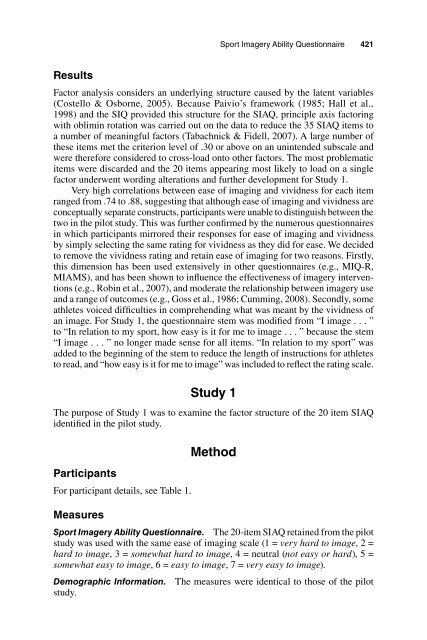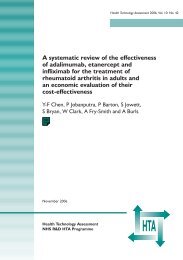Measuring Athlete Imagery Ability: The Sport ... - ResearchGate
Measuring Athlete Imagery Ability: The Sport ... - ResearchGate
Measuring Athlete Imagery Ability: The Sport ... - ResearchGate
You also want an ePaper? Increase the reach of your titles
YUMPU automatically turns print PDFs into web optimized ePapers that Google loves.
Results<br />
<strong>Sport</strong> <strong>Imagery</strong> <strong>Ability</strong> Questionnaire 421<br />
Factor analysis considers an underlying structure caused by the latent variables<br />
(Costello & Osborne, 2005). Because Paivio’s framework (1985; Hall et al.,<br />
1998) and the SIQ provided this structure for the SIAQ, principle axis factoring<br />
with oblimin rotation was carried out on the data to reduce the 35 SIAQ items to<br />
a number of meaningful factors (Tabachnick & Fidell, 2007). A large number of<br />
these items met the criterion level of .30 or above on an unintended subscale and<br />
were therefore considered to cross-load onto other factors. <strong>The</strong> most problematic<br />
items were discarded and the 20 items appearing most likely to load on a single<br />
factor underwent wording alterations and further development for Study 1.<br />
Very high correlations between ease of imaging and vividness for each item<br />
ranged from .74 to .88, suggesting that although ease of imaging and vividness are<br />
conceptually separate constructs, participants were unable to distinguish between the<br />
two in the pilot study. This was further confirmed by the numerous questionnaires<br />
in which participants mirrored their responses for ease of imaging and vividness<br />
by simply selecting the same rating for vividness as they did for ease. We decided<br />
to remove the vividness rating and retain ease of imaging for two reasons. Firstly,<br />
this dimension has been used extensively in other questionnaires (e.g., MIQ-R,<br />
MIAMS), and has been shown to influence the effectiveness of imagery interventions<br />
(e.g., Robin et al., 2007), and moderate the relationship between imagery use<br />
and a range of outcomes (e.g., Goss et al., 1986; Cumming, 2008). Secondly, some<br />
athletes voiced difficulties in comprehending what was meant by the vividness of<br />
an image. For Study 1, the questionnaire stem was modified from “I image . . . ”<br />
to “In relation to my sport, how easy is it for me to image . . . ” because the stem<br />
“I image . . . ” no longer made sense for all items. “In relation to my sport” was<br />
added to the beginning of the stem to reduce the length of instructions for athletes<br />
to read, and “how easy is it for me to image” was included to reflect the rating scale.<br />
Study 1<br />
<strong>The</strong> purpose of Study 1 was to examine the factor structure of the 20 item SIAQ<br />
identified in the pilot study.<br />
Participants<br />
For participant details, see Table 1.<br />
Measures<br />
Method<br />
<strong>Sport</strong> <strong>Imagery</strong> <strong>Ability</strong> Questionnaire. <strong>The</strong> 20-item SIAQ retained from the pilot<br />
study was used with the same ease of imaging scale (1 = very hard to image, 2 =<br />
hard to image, 3 = somewhat hard to image, 4 = neutral (not easy or hard), 5 =<br />
somewhat easy to image, 6 = easy to image, 7 = very easy to image).<br />
Demographic Information. <strong>The</strong> measures were identical to those of the pilot<br />
study.
















